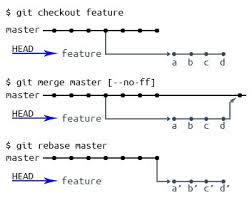Git - Difference between merge and rebase
Last modified: 2018-08-27 09:56
---Let's go back to basics: Git.
This powerful versioning tool is hugely underestimated by newcomers because "Oh jeez it's so hard to understand what's the difference between git pull origin master and git merge origin/master, and what the hell is this slash in the middle"?
Yeah, just trolling, but actually there's something awesome we can do and that's very simple "in the end": rebasing.
Start from here.
* 33facc8 (master) Commit 3 | | * 3b36f32 (second_branch) Detached commit | | |/ * 29af11f Commit 2 | * 1439f8e Commit 1
We will work on branch second_branch, which is created based on a previous version of the master branch. The second_branch has one commit more than master. But, between now and when I created the branch, someone commited on master.
Our branches diverge.
Problem: I need the modifications from Commit 3 to work on my branch (or my lead developer wants me to always keep my working directory up to date with the master).
Two possibilities here:
- Use
merge(orpullfor the lazy ones). - Use
rebase.
Reminder: we work on second_branch. It means we previously ran a git checkout second_branch command.
Summary
git merge {branch}
Applies modifications of the {branch} branch to the current branch, and if branches diverge (or --no-ff is specified), it will create a new "merge commit" indicating that the two branches were merged.
git rebase {branch}
Rewrites the current branch history . At first, it keeps all "new commits" of the current branch (starting from head) in memory, then applies all "missing" commits from the {branch} (which should inexorably fast-forward), and finally applies all kept-in-memory commits' modifications from the current branch, one-by-one, until every conflict (if there are some) is resolved, and changes the new commits' hashes.
And rebasing is just one component of Git.
Just look at for-each-ref command, or even log, you can do beautiful things with them!
